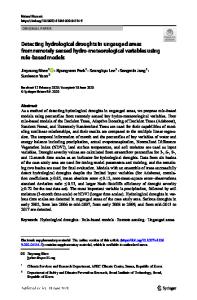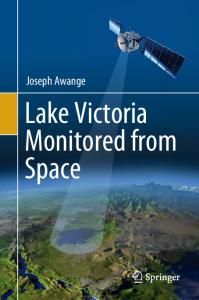From meteorological droughts to hydrological droughts: a case study of the Weihe River Basin, China
- PDF / 5,592,806 Bytes
- 13 Pages / 595.276 x 790.866 pts Page_size
- 26 Downloads / 379 Views
ORIGINAL PAPER
From meteorological droughts to hydrological droughts: a case study of the Weihe River Basin, China Panpan Zhao 1,2 & Haishen Lü 3 & Wenchuan Wang 1 & Guobin Fu 2 Received: 19 September 2018 / Accepted: 9 May 2019 / Published online: 30 May 2019 # Saudi Society for Geosciences 2019
Abstract The standard precipitation index (SPI) and streamflow drought index (SDI) were used in this study to investigate the relationship between meteorological and hydrological droughts in the Weihe River Basin, the largest tributary of the Yellow River—the 6th longest river in the world and the BMother River of China.^ Results showed that (1) the frequencies of both meteorological droughts and hydrological droughts have showed an increasing trend in the last 50 years in the Weihe River basin; (2) there was a strong relationship between meteorological and the hydrological droughts, which can be linked with a simple linear function; (3) the relationship between meteorological and the hydrological droughts varied in space and time; and (4) the differences between meteorological and the hydrological droughts have become more significant during the last 50 years. The presented results not only play an important reference in understanding the relationships between meteorological and hydrological droughts, but also have practical applications for regional water resource managements at catchment scale. Keywords Hydrological drought . Meteorological drought . Standard precipitation index (SPI) . Streamflow drought index (SDI) . The Weihe River Basin
Introduction Drought is a natural phenomenon and a natural hazard, and it occurs over most parts of the world, even in wet and humid regions (Dai 2011). Based on different disciplinary perspectives, drought can be separated into four categories (Sheffield and Wood 2012): meteorological drought, agricultural drought, hydrological drought, and socioeconomic drought. Among these different types of droughts, the hydrological cycle is the most important given the high dependence of many activities on surface water resources.
Editorial handling: Pradeep Naik * Guobin Fu [email protected] 1
Institute of Water Conservancy, North China University of Water Resources and Electric Power, Zhengzhou 450045, China
2
CSIRO Land and Water, Wembley, WA 6913, Australia
3
State Key Laboratory of Hydrology-Water Resource and Hydraulic Engineering, College of Hydrology and Water Resources, Hohai University, Nanjing 210098, China
Meteorological drought is one of the important factors affecting the hydrological drought (Gumus and Algin 2017). Due to atmospheric transport of anomalously warm and dry air, spatial migration of a drought event from meteorological to hydrological drought would occur (Joseph et al. 2009). It is called Bdrought propagation.^ In addition, propagation of drought is characterized by a number of features, which are related to the fact that the terrestrial part of the hydrological cycle acts as a low-pass filter to the meteorological forcing (Marković and Koch 2005). For exa
Data Loading...











